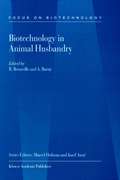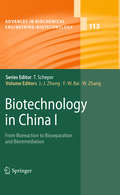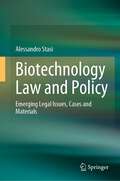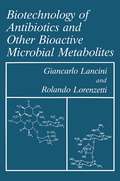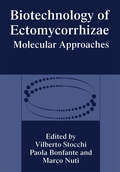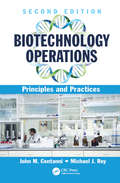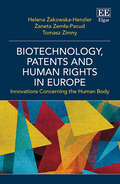- Table View
- List View
Biotechnology in Africa: Emergence, Initiatives and Future (Science Policy Reports #7)
by Florence Wambugu Daniel KamangaIn this book, Florence Wambugu and Daniel Kamanga of Africa Harvest Biotech Foundation International bring together expert African authorities to critique various biotechnology initiatives and project future developments in the field in Africa. For the first time, African voices from multidisciplinary fields as diverse as economics, agriculture, biotechnology, law, politics and academia, demand to be allowed to set the continent’s biotech development agenda. This book argues that there is a great future for biotechnology in Africa which sidesteps western interests that do not match those of the local populace. In these diverse chapters, Africa’s political and scientific leaders demand a greater say in how research and development funds are allocated and spent. They argue that Africa’s political leaders must see both clear benefits and have elbow-room to drive the change required. This is the way that African governments can employ workable policies, suitable biosafety legislation and regulation and respond effectively to public-private partnerships. Wambugu and Kamanga show that biotechnology has the potential to improve food security and standard of living as well as mitigate the detrimental effects of climate change on the African continent.
Biotechnology in Agriculture and Food Processing: Opportunities and Challenges
by Parmjit S. Panesar Satwinder S. MarwahaAn instructive and comprehensive overview of the use of biotechnology in agriculture and food production, Biotechnology in Agriculture and Food Processing: Opportunities and Challenges discusses how biotechnology can improve the quality and productivity of agriculture and food products. It includes current topics such as GM foods, enzymes, and prod
Biotechnology in Animal Husbandry (Focus on Biotechnology #5)
by R. Renaville A. BurnyAnimal biotechnology is a broad umbrella encompassing the polarities of fundamental and applied research including molecular modelling, molecular and quantitative genetics, gene manipulation, development of diagnostics and vaccines and manipulation of tissue or digestion metabolism by growth promoters. Although animal biotechnology in the broadest sense is not new, what is new is the level of complexity and precision involved in scientists' current ability to manipulate living organisms. This new book sets out to show that the important ideas in animal biotechnology are exciting and relevant to everyday experience. It represents an important update of the literature for research workers, lecturers, and advisers in animal science, but is also a core text for advanced undergraduate courses in animal science and biotechnology. It will be an essential acquisition for librarians in agriculture and veterinary science.
Biotechnology in blood transfusion: Proceedings of the Twelfth Annual Symposium on Blood Transfusion, Groningen 1987, organized by the Red Cross Blood Bank Groningen-Drenthe (Developments in Hematology and Immunology #21)
by L. R. Overby P. C. Das C. Th. SmitSibingaThis symposium is devoted to Biotechnology in Blood Transfusion; there are 22 experts discussing the state of the art in the application of monoclonal anti bodies, recombinant DNA technologies and heterologous expression systems to the improvement and sometimes replacement of blood products, charac terization of blood constituents, and the effect of these developments on blood transfusion procedures. Ten and maybe five years ago the title of a symposium such as this would have been Biosciences in blood transfusion, informing what basic developments in molecular biology, biochemistry and human physiology might pertain to blood transfusion in the distant future. That future is getting closer, and not only one is interested in basic developments in immunology, recognition and identification of viral and bacterial components and products, tissue and blood bloodgroup blood group typing, typing, but also in the potential application of these developments and their economic perspectives. That is what biotechnology is all alI about: basic science telIs tells us where and how we might look for new technologies, and the development of such tech nologies is only possible if there is a perspective for improvement in quality, safety, acceptance or performance to cost ratio.
Biotechnology in Cartoons
by Reinhard Renneberg Viola Berkling Ming-Fai ChowThe book introduces to the basics of biotechnology and lets young and old cartoon fans enjoy science in a relaxed and comprehensive way. Together with Professor Nanoroo, the story's likeable protagonist, the reader discovers on how biotechnology influences our daily life. The real science behind the funny cartoons is explained briefly in separate boxes.The Story:A shooting star falls to Earth in the Kingdom Macronesia.When King Richard VIII. examines the stardust under a super microscope, he discovers a small nanoscopic intelligent being in a micro-spacecraft ... Professor Nanoroo came down from planet Nano to Earth to understand human biotechnology. Curious, he communicates with „Earthlings“, all asking hundreds of questions relating their life.Nanoroo encounters bread baking and beer brewing yeasts; disease makers and health- stabilizing bacteria; fungi producing drugs against bacteria. He experiences many adventures, rescues the king's brother from a heart attack, measures King Richard’s glucose level and the fitness of his racehorses, watches plants with their insect repellents and eats the famous and vitamin-rich „Golden Rice“.The authors:Reinhard Renneberg has been working as Professor of Analytical Biotechnology at the Hong Kong University of Science and Technology (www.ust.hk), the top university of Asia, since 1995. He is the author of several textbooks, including A spoonful of Biotech and Katzenklon, Katzenklon. Along with Viola Berkling, Master of Oriental Languages, he has published already in its fourth edition the extremely successful internationally recognized textbook Biotechnology for Beginners. It is translated into English, Spanish, Chinese, Japanse and Korean. The duo stands for inspiring creative as well as innovative knowledge transfer of accurate, awesome illustrated and non-boring texts from the world of biotechnology.Ming-fai Chow, the Hong Kong cartoonist has created the beautiful and excellent cartoons for this book.Story: Reinhard Renneberg, Viola Berkling, Ming Fai Chow (cartoons)Graphic layout and illustration on academic pages: Dascha SüßbierCartoon coloring: Steffi Kaiser
Biotechnology in China I: From Bioreaction to Bioseparation and Bioremediation (Advances in Biochemical Engineering/Biotechnology #113)
by Jian-Jiang Zhong Feng-Wu Bai Wei Zhang J. Chen J. Feng E. J. Hahn F. Li G. Q. Lin F. F. Liu X. W. Liu W. Y. Lu C. Ma H. N. Murthy B. J. Ni K. Y. Paek Y. C. Shen G. P. Sheng Q. H. Shi Y. Sun J. H. Xiao J. H. Xu P. Xu B. Yu H. L. Yu H. Q. Yu Y. Zhang R. C. Zheng Y. G. Zheng J. J. ZhongIn recent years, biotechnology research and development (R&D) in China has been receiving increasing attention from the world. With the open-door policy of the Chinese government, many international publications (for academia) and large market potential (for industry) constitute the two big reasons for the above phen- enon. Biotechnology has become one of the priorities in Mainland China for so- ing many important problems, such as food supply, health care, environment protection, and even energy. The central government has been implementing a c- ple of programs which cover a wide spectrum in basic research, high-tech devel- ment and industrialization, such as Basic Research Program (973 Plan), Hi-Tech R&D Program (863 Plan), Key Science & Technology Problem Solving Program (Gong-guan Plan), as well as the establishment of centers of excellence - Key Laboratories and Engineering Centers, etc. The funding from various local gove- ments and industry for R&D has also been increasing continuously. Biotechnology centers in Shenzhen, Shanghai and Beijing have been established. There are more than 400 universities, research institutes and companies and a total of over 20,000 researchers involved in biotechnology in the Mainland. The number of research papers published internationally and patent applications is also increasing rapidly. In addition, the huge market potential with about 1. 4 billion population, which is already open to the outside world, has provided numerous opportunities for int- national and domestic companies to invest in biotechnology, which pushes forward the biotechnology industrialization in China.
Biotechnology in India I (Advances in Biochemical Engineering/Biotechnology #84)
by S. K. Basu D. Bhardwaj V. S. Chauhan N. Dhar B. N. Johri J. P. Khurana A. Mukhopadhyay G. Padmanaban A. Sharma M. Sharma R. Swarup A. K. Tyagi J. S. VirdiThe biotechnology business in India with an increase from USD 500 million in 1997 and reaching an estimated USD I billion next year health related prod ucts accounting for 60%, agro and veterinary products together 15%, and con tract R&D, reagents, devices and supplies adding up to the remaining 25% of which the diagnostics share was about 10% of the total surely presented an encouraging picture even five years ago. While volumes have increased, the pat tern has not. According to a report, prepared by McKinsey & Co, India's Phar maceutical industry including domestic and export sales and contract services totals nearly USD 5 billion. Furthermore, the company optimistically projects the growth to a factor of five fold only if both the industry and the government are able to put in place achievable solutions that must take care of the formida ble obstacles preventing further growth. If this assessment is correct, then the established transformation made by IT growth should also provide the confi dence required by the high expectations for biotechnology which have arisen in the country in recent years. Some contributors to this are overenthusiastic these are bureaucrats, some retired scientists and of course the complacent politicians who have the least knowledge of what the new biotechnology is all about. However, there are clear indications of biotechnology growth demon strated by a few but rapidly expanding biotech companies such as Biocon Ltd, Shantha Biotech (P) Lid, Dr.
Biotechnology in India II (Advances in Biochemical Engineering/Biotechnology #85)
by S. Chand T. K. Ghose P. Ghosh S. K. Gupta B. B. Lohray K. Mazumdar-Shaw P. Mishra S. Nath A. K. Panda S. SuryanarayanThe biotechnology business in India with an increase from USD 500 million in 1997 and reaching an estimated USD 1 billion next year health related prod ucts accounting for 60%, agro and veterinary products together 15%, and con tract R&D, reagents, devices and supplies adding up to the remaining 25% of which the diagnostics share was about 10% of the total surely presented an encouraging picture even five years ago. While volumes have increased, the pat tern has not. According to a report, prepared by McKinsey & Co, India's Phar maceutical industry including domestic and export sales and contract services totals nearly USD 5 billion. Furthermore, the company optimistically projects the growth to a factor of five fold only if both the industry and the government are able to put in place achievable solutions that must take care of the formida ble obstacles preventing further growth. If this assessment is correct, then the established transformation made by IT growth should also provide the confi dence required by the high expectations for biotechnology which have arisen in the country in recent years. Some contributors to this are overenthusiastic these are bureaucrats, some retired scientists and of course the complacent politicians who have the least knowledge of what the new biotechnology is all about. However, there are clear indications of biotechnology growth demon strated by a few but rapidly expanding biotech companies such as Biocon Ltd, Shantha Biotech (P) Ltd, Dr.
Biotechnology in Medical Sciences
by Firdos Alam KhanAs the field of medical biotechnology grows with new products and discoveries, so does the need for a holistic view of biotechnology in medicine. Biotechnology in Medical Sciences fulfills that need by delivering a detailed overview of medical biotechnology as it relates to human diseases and epidemiology, bacteriology and antibiotics, virology and
Biotechnology in Personal Care
by Raj LadDivided into three expansive sections on biotechnological advances, applications, and research prospects, this reference provides expert summaries of the state-of-the-science in personal care product development-clearly depicting the latest breakthroughs and practices in biotechnology for the formulation and increased safety of new personal care in
Biotechnology in South Korea, Taiwan and Singapore
by Robert YuanThis study examines biotechnology in the newly industrializing countries of Singapore, South Korea and Taiwan. Until recently, these countries have been known mainly for their first tentative moves into high technology. Government policy, research organizations and companies are covered.
Biotechnology in Surgery (Updates in Surgery)
by Alfonso Barbarisi Paolo Bechi Paolo Innocenti Carlo A. Redi Francesco RossoThe 20th century has finished, the century when surgery took huge steps forward thanks to progress in technology. Now we have entered the "century of biotechnologies", which will not only generate progress in surgery, but also lead to a real "cultural revolution" that will completely change approaches to solving different problems in medicine. The aim of this book is to bring surgeons closer to biotechnologies and to overcome the cultural gap dividing them from these new approaches. Biotechnologies are already proposed and used at different levels in surgical practice: in diagnostic technique, enabling practitioners to identify diseases at an early stage and follow their molecular modification over time; and in tissue engineering, where the use of "smart scaffolds" offers a possible answer to increasing demand for biocompatible tissues and organs in transplantation surgery. This volume focuses on the emerging field of stem cells, analyzing both their role as possible players in originating and perpetuating cancer – "cancer stem cells" – and, conversely, their extraordinary therapeutical potential. An additional section is dedicated to the evaluation and application of derived molecular factors that can enhance the physiological processes that are fundamentally important in surgery, such as hemostasis and wound healing. Surgeons have always been technologists, in the sense that since surgery began they have always needed technology, beginning with a scalpel and surgical instruments. They have always cooperated with technologists. However, in the new century, the first one of the millennium, a rapid increase in knowledge that is outside the realm of the surgeon’s traditional technological training is imposing itself – hence the aim of this book. It is now urgent to encourage surgeons to embrace this knowledge (biotechnology) with confidence. By its very nature, biotechnology is completely different from the technologies used so far, because it escapes the senses of sight and touch, which up to now have been the essence of the surgeon’s work. The cellular and molecular dimensions of biotechnologies are still far removed from most of the recent advances in modern surgical techniques. A common language between surgeons and biotechnologists will create further, revolutionary, progress in surgical sciences in the twenty-first century.
Biotechnology Law and Policy: Emerging Legal Issues, Cases and Materials
by Alessandro StasiThis book covers an extensive range of issues raised by biotechnological advancements from a regulatory perspective. Written in a clear and readable style, its main objective is to give readers an idea of the relationship between biotechnology and law. Biotechnology advancements and their ethical, moral, economic, and social implications in different fields and the consequential normative demands on the law are crucial to this book. The chapters cover a multitude of themes and some of the most important legal issues arising in relation to biotechnology, including the historical development of a legal framework sufficient to protect public safety, the current biotechnology regulatory system, and the rules directing the primary agencies that regulate the products of biotechnology, namely the US Food and Drug Administration, the US Department of Agriculture, and the US Environmental Protection Agency, patents and IP rights in biotechnology, the regulation of human genome editing and its impact on health research, law and emerging genome editing technologies from recombinant DNA to CRISPR/Cas9, the development of legal principles to protect property rights in the human body and allow the efficient use of human tissue, organs, DNA, and cell-lines in medical research, and legal issues arising from the use of genetic engineered plants and animals.Presenting arguments that have been drawn from careful examination of various international documents and decisions made by legal institutions and judicial bodies, this book would be a valuable read for practitioners as well as academics of biotechnology law.
Biotechnology of Anti-diabetic Medicinal Plants
by Saikat Gantait Sandeep Kumar Verma Amit Baran SharangiThis book is a unique overview of insights on the genetic basis of anti-diabetic activity, chemistry, physiology, biotechnology, mode-of-action, as well as cellular mechanisms of anti-diabetic secondary metabolites from medicinal plants. The World Health Organization estimated that 80% of the populations of developing countries rely on traditional medicines, mostly plant drugs, for their primary health care needs. There is an increasing demand for medicinal plants having anti-diabetic potential in both developing and developed countries. The expanding trade in medicinal plants has serious implications on the survival of several plant species, with many under threat to become extinct. This book describes various approaches to conserve these genetic resources. It discusses the whole spectrum of biotechnological tools from micro-propagation for large-scale multiplication, cell-culture techniques to the biosynthesis and enhancement of pharmaceutical compounds in the plants. It also discusses the genetic transformation as well as short- to long-term conservation of plant genetic resources via synthetic seed production and cryopreservation, respectively. The book is enriched with expert contributions from across the globe. This reference book is useful for researchers in the pharmaceutical and biotechnological industries, medicinal chemists, biochemists, botanists, molecular biologists, academicians, students as well as diabetic patients, traditional medicine practitioners, scientists in medicinal and aromatic plants, Ayurveda, Siddha, Unani and other traditional medical practitioners.
Biotechnology of Antibiotics and Other Bioactive Microbial Metabolites
by G. Lancini R. LorenzettiIn response to the field's need for an introductory text, the authors have distilled the vast and scattered literature relating to the biotechnology of microbial secondary metabolites. General biology, biosynthesis, the search for novel metabolites, and techniques for strain improvement are all discussed to provide undergraduate and graduate students with a concise, readable overview of the field.
Biotechnology of Ectomycorrhizae: Molecular Approaches
by P. Bonfante M. Nuti V. StocchiForty years after the discovery of the helix nature of DNA and more than twenty after the first applications of recombinant DNA technology to the pharmaceutical industry, the Pandora's vase of biotechnology seems far from being empty. New products for agriculture and the food industry are constantly being placed on the market, and powerful monitoring techniques have been developed to track non-modified and genetically modified vaccines, viruses, microbes and plants released into the environment. Molecular approaches for taxonomic purposes, which might also be useful for quality control and assurance, have been successfully developed and used for taxonomic purposes in the last decade for both prokaryotic and eukaryotic cells, including yeasts and filamentous fungi. Mycorrhizae are one example of a traditional biotechnology that can greatly benefit from the latest molecular approaches. These universal symbioses between soil fungi and plant roots playa central role in most of the natural and agricultural ecosystems in such key processes as nutrient cycling, soil structural conservation and plant health. For these reasons, mycorrhizae have been successfully used to improve the quality of forest and agricultural seedlings, to produce high-quality micropropagated plants and to increase the production of edible mushrooms of high economic value, such as truffles. However, although controlled inoculation of oak and hazel seedlings with ectomycorrhizal truffles has been carried out for decades in France and Italy, and is still expanding commercially, several technological gaps remain to be filled.
Biotechnology of Extremophiles: Advances and Challenges (Grand Challenges in Biology and Biotechnology #1)
by Pabulo H. RampelottoAimed at research scientists and biotechnologists, this book is an essential reading for those working with extremophiles and their potential biotechnological application. Here, we provide a comprehensive and reliable source of information on the recent advances and challenges in different aspects of the theme. Written in an accessible language, the book is also a recommended as reference text for anyone interested in this thriving field of research. Over the last decades, the study of extremophiles has provided ground breaking discoveries that challenge our understanding of biochemistry and molecular biology. In the applied side, extremophiles and their enzymes have spawned a multibillion dollar biotechnology industry, with applications spanning biomedical, pharmaceutical, industrial, environmental, and agricultural sectors. Taq DNA polymerase (which was isolated from Thermus aquaticus from a geothermal spring in Yellowstone National Park) is the most well-known example of the potential biotechnological application of extremophiles and their biomolecules. Indeed, the application of extremophiles and their biologically active compounds has opened a new era in biotechnology. However, despite the latest advances, we are just in the beginning of exploring the biotechnological potentials of extremophiles.
Biotechnology of Hairy Root Systems (Advances in Biochemical Engineering/Biotechnology #1192)
by Pauline M. DoranVictor P. Bulgakov, Yuri N. Shkryl, Galina N. Veremeichik, Tatiana Y. Gorpenchenko and Yuliya V. Vereshchagina: Recent Advances in the Understanding of Agrobacterium rhizogenes-Derived Genes and Their Effects on Stress Resistance and Plant Metabolism. Le Zhao, Guy W. Sander and Jacqueline V. Shanks: Perspectives of the Metabolic Engineering of Terpenoid Indole Alkaloids in Catharanthus roseus Hairy Roots. Jian Wen Wang and Jian Yong Wu: Effective Elicitors and Process Strategies for Enhancement of Secondary Metabolite Production in Hairy Root Cultures. Amanda R. Stiles and Chun-Zhao Liu: Hairy Root Culture: Bioreactor Design and Process Intensification. Marina Skarjinskaia, Karen Ruby, Adriana Araujo, Karina Taylor, Vengadesan Gopalasamy-Raju, Konstantin Musiychuk, Jessica A. Chichester, Gene A. Palmer, Patricia de la Rosa, Vadim Mett, Natalia Ugulava, Stephen J. Streatfield and Vidadi Yusibov: Hairy Roots as a Vaccine Production and Delivery System. Zahwa Al-Shalabi and Pauline M. Doran: Metal Uptake and Nanoparticle Synthesis in Hairy Root Cultures.
Biotechnology of Medicinal Plants with Antiallergy Properties: Research Trends and Prospects
by Amit Baran Sharangi Saikat Gantait Jayoti MajumderThis book comprehensively covers critically investigated information on medicinal plants prioritized for their anti-allergy properties. It offers insights into strategies related to the distribution, mechanism of action, and assessment of antiallergic medicinal plants, and also delves into crucial aspects of modern biotechnological tools, addressing their implementation challenges, presenting innovative approaches through case studies, and exploring opportunities for nanotechnologies. These elaborated discussions aim to raise awareness and bridge the gap between human health and the biodiversity of antiallergic medicinal plants. As the book navigates the uncertainties of plant-based medicines in the post-COVID-19 era, it provides real-world applications showcasing the specific utility of medicinal plants through advanced biotechnological insights. This book covers several medicinal plants associated with antiallergy, exploring their modes of action, available secondary metabolites,and estimation methods. It also emphasizes all modern biotechnological interventions aimed at propagating, multiplying, and conserving this unique treasure trove of medicinal plants. The World Health Organization estimated that 80% of the populations of developing countries rely on traditional medicines, mostly plant drugs, for their primary health care needs. Increasing demand in both developing and developed countries resulted in the expanding trade of medicinal plants and has serious implications for the survival of several plant species, with many under threat of becoming extinct. This book describes various approaches to conserving these genetic resources. It discusses the whole spectrum of biotechnological tools from micro-propagation for large-scale multiplication and cell-culture techniques to the biosynthesis and enhancement of pharmaceutical compounds in plants. It also discusses the genetic transformation as well as short- to long-term conservation of plant genetic resources via synthetic seed production and cryopreservation, respectively. This reference book is useful for researchers in the pharmaceutical and biotechnological industries, medicinal chemists, biochemists, botanists, molecular biologists, academicians, students as well as allergic patients, traditional medicine practitioners, scientists in medicinal and aromatic plants, and other traditional medical practitioners.
Biotechnology Operations: Principles and Practices
by John M. CentanniBecause of rapid developments in the biotechnology industry-and the wide range of disciplines that contribute to its collective growth-there is a heightened need to more carefully plan and fully integrate biotech development projects. Despite the wealth of operations experience and associated literature available, no single book has yet offered a c
Biotechnology Operations: Principles and Practices, Second Edition
by John M. Centanni Michael J. RoyThis book describes seven areas in the field of biotechnology operations as practiced by biopharmaceutical firms and nonprofit institutions. Revisions focus upon changes that have occurred in several areas over the past six years, with emphasis on regulatory, biomanufacturing, clinical and technical information, along with processes and guidlines that have added to the discipline. Examples are increased for new technical fields such as cell and tissue engineering. Further, illustrations or figures are added to each chapter to emphasize particular points.
Biotechnology Operations: Principles and Practices, Second Edition
by John M. Centanni Michael J. RoyThis book describes seven areas in the field of biotechnology operations as practiced by biopharmaceutical firms and nonprofit institutions. Revisions focus upon changes that have occurred in several areas over the past six years, with emphasis on regulatory, biomanufacturing, clinical and technical information, along with processes and guidlines that have added to the discipline. Examples are increased for new technical fields such as cell and tissue engineering. Further, illustrations or figures are added to each chapter to emphasize particular points.
Biotechnology, Patents and Human Rights in Europe: Innovations Concerning the Human Body
by Helena Żakowska-Henzler Żaneta Zemła-Pacud Tomasz ZimnyThis innovative book explores the complex interplay between intellectual property for biotechnological innovations and human rights. Examining the clash between the drive to incentivise innovations that can fulfil human needs and the desire to grant global access to healthcare technologies, it presents thoughtful solutions to the challenges of protecting the human rights of all parties impacted by biotechnological patents and other relevant IP rights.After laying out the essential biotechnological innovations of the last 40 years, the authors conduct an in-depth analysis of European exclusive rights relating to biotechnology and healthcare, with particular attention to five key European jurisdictions - France, Germany, Italy, Poland and the UK. Delving into complex legal and ethical disputes over the rights to privacy, integrity, autonomy, health and science, the book argues for a more balanced patent system, protecting both human rights and intellectual property.This book will be a thought-provoking read for legal scholars, practitioners and policy-makers in the fields of biotechnology, pharmaceutical law, human rights law and intellectual property law. With its in-depth discussion of cutting-edge advances in biotechnology and the laws related to it, it will also prove enlightening for scholars and students interested in engaging with the field for the first time.
Biotechnology Policy across National Boundaries: The Science-Industrial Complex
by D. WestA globalization of innovation has produced the most massive spurt in biotechnology in world history. Businesses, universities, and non-governmental organizations are collaborating to produce a "science-industrial complex" in biotechnology. Using case studies of stem cell research, cloning, genetically modified food, in-vitro fertilization, and chimeras in a number of Eastern and Western countries around the world, I argue that much of this biotech activity is global in nature and independent of state control. This shift in the relative influence of state and non-state actors has led to the virtual deregulation of biotechnology and the liberation of innovation from geo-political constraints. These trends post a number of interesting social, political, and ethical issues for the contemporary period and suggest the need to rethink how controversial moral issues are handled by the science-industrial complex.
Biotechnology Products in Everyday Life (EcoProduction)
by Menka Khoobchandani Arpita SaxenaThis book explores a sampling of the most powerful and enterprising efforts to achieve biotechnological goals by means of various interdisciplinary approaches. From the fabrication of extremely small units to achieve specific objectives through nano-bio-technology, to devices with artificial intelligence, gene therapy for cerebrovascular anomalies, biodegradable plastics, the use of phyto-stem cells in cosmetology, CarT cell immune therapy, targeted therapies for cancer, 3D printed bones developed by the University of Wollongong in Australia, the sickle cell chip developed by IIT Bombay, and innovative sustainable energy solutions, the book includes a colorful spectrum of reviews on current and future biotech products. Gathering contributions by an international team of researchers, this book offers its audience, and particularly younger readers, revealing information on current and upcoming smart technologies.


